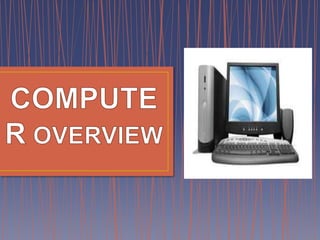Report
Share

Recommended
More Related Content
What's hot
What's hot (19)
13. Computer Systems Input And Output Architecture

13. Computer Systems Input And Output Architecture
Similar to computer system overview
Similar to computer system overview (20)
CS304PC:Computer Organization and Architecture Session 1 Introduction .pptx

CS304PC:Computer Organization and Architecture Session 1 Introduction .pptx
Pre requisite of COA- for Micro controller Embedded systems

Pre requisite of COA- for Micro controller Embedded systems
Recently uploaded
TEST BANK For Principles of Anatomy and Physiology, 16th Edition by Gerard J. Tortora, Verified Chapters 1 - 29, Complete Newest Version.TEST BANK For Principles of Anatomy and Physiology, 16th Edition by Gerard J....

TEST BANK For Principles of Anatomy and Physiology, 16th Edition by Gerard J....rightmanforbloodline
Recently uploaded (20)
API Governance and Monetization - The evolution of API governance

API Governance and Monetization - The evolution of API governance
Navigating Identity and Access Management in the Modern Enterprise

Navigating Identity and Access Management in the Modern Enterprise
Vector Search -An Introduction in Oracle Database 23ai.pptx

Vector Search -An Introduction in Oracle Database 23ai.pptx
Cloud Frontiers: A Deep Dive into Serverless Spatial Data and FME

Cloud Frontiers: A Deep Dive into Serverless Spatial Data and FME
TEST BANK For Principles of Anatomy and Physiology, 16th Edition by Gerard J....

TEST BANK For Principles of Anatomy and Physiology, 16th Edition by Gerard J....
Less Is More: Utilizing Ballerina to Architect a Cloud Data Platform

Less Is More: Utilizing Ballerina to Architect a Cloud Data Platform
Choreo: Empowering the Future of Enterprise Software Engineering

Choreo: Empowering the Future of Enterprise Software Engineering
Intro to Passkeys and the State of Passwordless.pptx

Intro to Passkeys and the State of Passwordless.pptx
Tales from a Passkey Provider Progress from Awareness to Implementation.pptx

Tales from a Passkey Provider Progress from Awareness to Implementation.pptx
WSO2 Micro Integrator for Enterprise Integration in a Decentralized, Microser...

WSO2 Micro Integrator for Enterprise Integration in a Decentralized, Microser...
Elevate Developer Efficiency & build GenAI Application with Amazon Q

Elevate Developer Efficiency & build GenAI Application with Amazon Q
Polkadot JAM Slides - Token2049 - By Dr. Gavin Wood

Polkadot JAM Slides - Token2049 - By Dr. Gavin Wood
DEV meet-up UiPath Document Understanding May 7 2024 Amsterdam

DEV meet-up UiPath Document Understanding May 7 2024 Amsterdam
WSO2's API Vision: Unifying Control, Empowering Developers

WSO2's API Vision: Unifying Control, Empowering Developers
computer system overview
- 2. • A computer is an electronic device that can perform many operations in accordance with a set of instructions called program..
- 3. INPUT UNIT CPU (Central Processing Unit) OUTPUT UNIT THE MEMORYArithmetic Logic Unit (ALU) Control Unit (CU)
- 4. • Input Unit • convert data and instructions into electronic form for input into the computer. • E.g.: Keyboard, mouse, OMR(Optical Mark Reader)etc. • Output Unit • convert electronic data produced by the computer system and display them in a form that people can understand. • E.g.: printer, plotter, VDU(Visual Display Unit), etc.
- 5. • The CPU • manipulates raw data into more useful form and controls the other parts of the computer system. • The ALU performs the computer’s principal logical and arithmetic operations. • The CONTROL UNIT coordinates and controls the other parts of the computer system. • The Memory • A memory cell can be defined as a device which can store a symbol selected from a set of symbols. • Unit of memory is byte. • 1byte = 8bits
- 6. Hardware consists of 5 primary components: INPUT DEVICES CPU MEMORY OUTPUT DEVICES STORAGE DEVICES
- 7. Software is classified into 3 categories: OPERATING SYSTEM LANGUAGE PROCESSOR APPLICATION SYSTEM
- 8. • Computer System consists of: 1. The hardware 2. The operating system 3. The application software 4. The human ware(users)
- 9. 1. Manages and Interacts with Computer Hardware 2. Provides and Manages System Security 3. Provides the System Interface 4. Provides the Interface for Application Software 5. Program creation 6. Program execution 7. Input/output operations 8. Error detection 9. Resource allocation 10.Protection
- 10. • Language processors are given below: i. Assembler: converts program written in assembly language to machine language. ii. Interpreter: converts a HLL program to machine language by converting and executing it line by line. iii. Compiler: converts the HLL program to machine language by converting it in one go and report all the errors by line.
- 11. • Customised Application software: it is developed to meet all the requirements specified by the user. However it cannot be directly installed on any other computer as the requirement may differ. • General Application software: it is developed by keeping all the general requirements in mind required to carry out a specific task.
- 12. Strength I. Speed II. High storage III. Accuracy IV. Reliability V. versatility Weakness I. Lack of decision of power making II. IQ zero
- 13. 1. ABACUS(3000BC) 2. NAPIER’ S LOGS AND BONES(1662) 3. PASCALS ADDING MACHINE(1642) 4. LEIBNITZ COMPUTER(1671) 5. JACQUARDS LOOM(1801) 6. BABBAGES DIFFERENCE ENGINE(1822) 7. BABBAGES ANALYTICAL ENGINE(1833) 8. HOLLERITHS MACHINE(1887) 9. MARK-1(1943)
- 15. 3RD GENERATION 4TH GENERATION 5TH GENERATION
- 16. • ENIAC(1946)----------- • EDVAC(1950)---------- • EDSAC(1949)---------- • UNIVAC-1(1951)------ • Electronic Numerical Integrator And Calculator • Electronic Discrete Variable Automatic Computer • Electronic Delay Storage Automatic Computer
- 17. ENIAC
- 18. EDVAC
- 19. EDSAC
- 20. UNIVAC
- 21. • KEY FEATURES OF SAME: 1. Transistor replaced vacuum tube 2. Smaller compared to 1st generation 3. Generate less heat 4. Low electricity consumption 5. More reliable and faster 6. Core memory developed 7. Magnetic tapes and disks used 8. First operating systems developed
- 22. Model Size Area of application IBM 1401 Small to medium Business IBM 1620 Small Scientific IBM 7094 Large Scientific and business CDC 1604 Medium to Large Scientific CDC 3600 Large Scientific RCA 501 Medium Business UNIVAC 1108 Large Scientific and business
